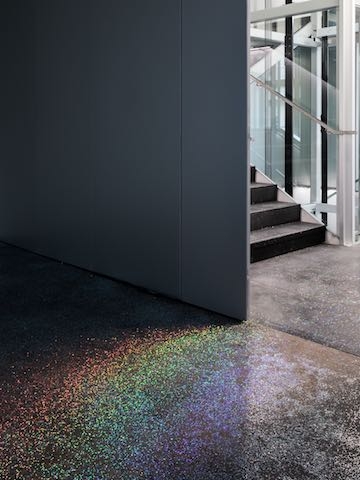A rare project in Paris by Rem Koolhaas and his architectural firm OMA, Lafayette Anticipations is a renovated nineteenth-century industrial building for Galeries Lafayette’s art fondation, which in turn commissions new work by artists, designers and fashion designers. Located in the swish Marais, encompassing exhibition space, workspaces, café and shop, it’s described in press materials as a ‘curatorial machine’. Since the main architectural feature is four mobile platforms within a steel-and-glass ‘exhibition tower’, one might also call it modular, in which sense it echoes previous OMA projects: the Maison Lemoine in Bordeaux, the Wyly Theater in Dallas. For Lafayette Anticipations, then, it likely seemed appropriate to reach out to Lutz Bacher, an artist who embodies the unfixed.
For those needing a recap, Bacher has been postmedium since the 1970s, an enigmatic and reclusive American wrapped in a German pseudonym, her age and gender long obscured. She’s a figure who, even though she now does commissions for art fairs and the like, moves slantwise – and so it is here. Permitted to scale the spaces of Lafayette Anticipations to her liking, she has – almost comically – seemingly ignored the opportunity; the floors sit in a regular, defaultlike position. There is nothing on the ground level except loudspeakers, emitting a vaguely thundery rumble. Go up a level and you get what still feels like a prelude, with nothing on the central floorspace except a scatter of glitter and, projected around the mezzanine, multiple videos showing a beach scene. The soundtrack you’ve been hearing, you now realise, is wind blowing into a camera’s (or smartphone’s) microphone. The footage centres on some Second World War bunkers, now slathered with graffiti.
First we see them at a distance, then we move in – the occasional plucky beachgoer scooting around despite the unseasonal weather – and we’re privy to the sprayers’ tags. The filmmaker roams as if trying to figure something out. It’s ominous, as if predicting more war to come, and yet you see how the trick is done: Bacher has taken something in the world and added atmosphere and opacity, as she typically does. Her position, past works have suggested, is that things mean what they mean in the moment, and this is a kind of freedom. You keep moving and this footage repeats on the next floor up, the artist seemingly throwing the space away. At the top, a glassed-in viewing platform looks out over the greyish city, and Bacher has again seemingly rejected it – thanks to reflective gauze on the windows, you see yourself as much as what’s out there. There’s more glitter on the floor. The artist is well aware, and wants you to be aware that she’s aware, of the glitziness of this commission.
The dynamics of the whole, then, are very ‘now’. Perennially edgy artist, aware of how the divisions between cool and commerce are collapsing, agrees to dally with culture-leveraging commercial enterprise but still doesn’t want to be bought. She acts up, but does so in a way that serves the commercial enterprise’s – and the architect’s – needs: because there’s not much to look at, the space becomes the star. And yet Bacher’s etiolated project, if you’re open to it, still gets the last word, the last twist. The show is named after, and pointedly anglicises, Le Silence de la Mer, a 1942 novel by Jean Bruller (who himself worked under the pseudonym Vercors). Published clandestinely in occupied Paris, it concerns an act of resistance by an old man and his niece, whose strategy is muteness; they refuse to speak to the German officer occupying their house. Knowing that, you look again at what Bacher has and hasn’t done here, listen to the soundtrack’s abstract roar, and maybe the floor moves under your feet.
Lutz Bacher: The Silence of the Sea at Lafayette Anticipations, Paris, 10 March – 30 April
From the May 2018 issue of ArtReview
